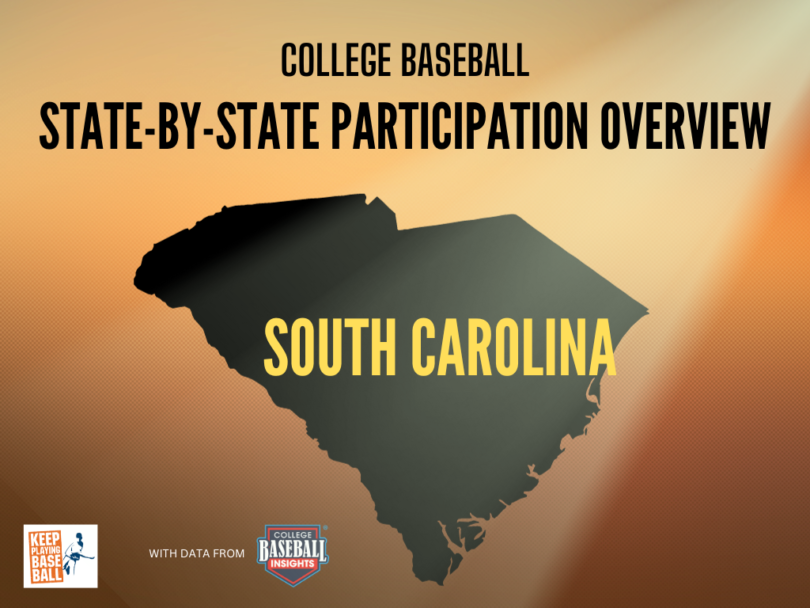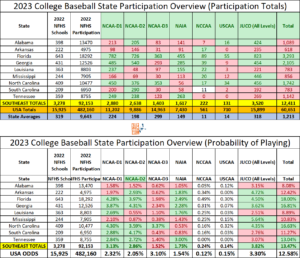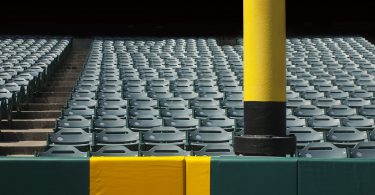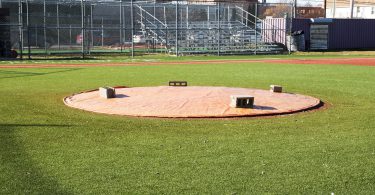You’re interested in playing college baseball, but what are your chances of making it to the next level? While many tout national probability as gospel, it turns out your odds of playing at the next level vary greatly depending on where you live.
If you live in South Carolina and are wondering what percentage of high school graduates from your state play at each college level and where they are playing, you’ve come to the right place. In this article, we team up with our friends at College Baseball Insights to provide you with state-level overview of your chances to play at the next level.
You can see an overview of our resources, methodology, and limitations on our College Baseball Participation Overview Main Page, as well find overviews on other states and regions.
South Carolina by the Numbers
In the table below, you’ll see how many high school players from South Carolina are playing at each level of college baseball, the probability of playing at each college level, and how South Carolina compares nationally and to other states in the Southeast Region. You can see the complete Southwest breakdown HERE.
Where Are They Playing?
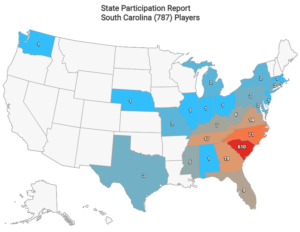
South Carolina Players by Division (787)

Image and data credit: College Baseball Insights
The Breakdown
South Carolina has the 2nd fewest high school baseball participants of any state in the Southeast with just under 7,000. Overall, the Palmetto State moves players on to the next level at a 11.27% rate. This is below both the national and regional average by more than 1% points. The D2 level is where South Carolina has the strongest pipeline. 4.17% of South Carolinians move on to play at the D2 level, surpassing the regional (2.86%) and national (2.05%) averages by a good amount. That’s good enough for 2nd best in the region. The state’s 2.88% rate of sending players to the D1 level is above the national average (2.32%) and the 5th best mark in the southeast. South Carolina struggles with every other major level. It’s 2.76% JUCO participation rate is 2nd worst in the region, as are the dismal 0.43% D3 and 0.83% NAIA participation rates. As we’ve seen playing out in our regional overviews, the participation rates often mirror the in-state playing opportunities. The Palmetto state has the best numbers where the most programs exist. 13 D2 and 10 D1 programs are joined by only 3 NAIA and 6 JUCO programs. There are no D3 options in-state.
Want to see additional states and regional breakdowns? Find them HERE.
Limitations
This article was written with data and insights from 3rd party sources, College Baseball Insights and NFHS High School Participation Data. Data and insights are subject to revision and/or change. We’ve attempted to display as accurate a picture as possible with the information that is available. Readers should be aware that college baseball roster data is fluid and changes throughout the year. Every attempt is made to reconcile data and keep up with changes, but this article may not reflect the changes or updates from 3rd parties. Insights cannot account for gap year programs, misreported roster information, or other inaccuracies which may slightly alter the numbers and percentages used in this article. Insights are subject to change and are based on best available information.

